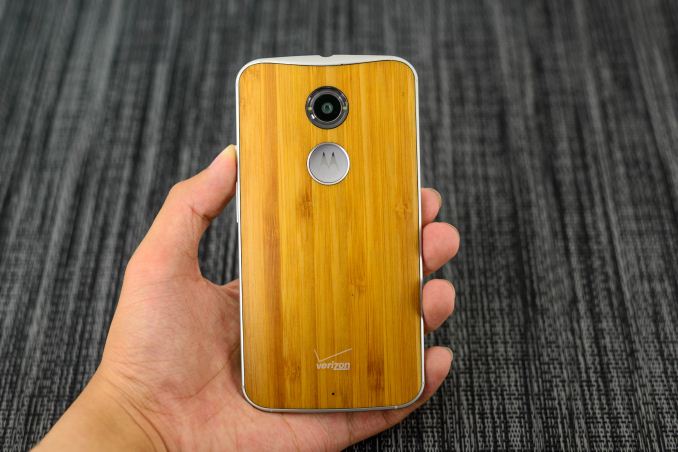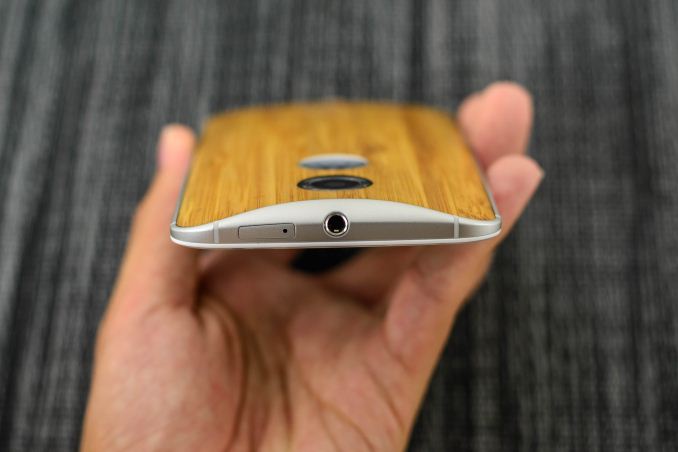The New Motorola Moto X (2nd Gen) Review
by Joshua Ho on September 17, 2014 9:00 AM EST- Posted in
- Smartphones
- Motorola
- Android
- Mobile

Introduction
While I talked about Motorola’s issues in the launch article for the new Moto X, it’s well worth repeating. Motorola has been through a lot these past few years. Once the iconic symbol of Android with their Droid smartphones, Motorola had lost its way. It wasn’t unusual to see one phone launch after the other, with no real regard for strategy, and no real cohesive message to tie all of their devices together. If anything, there was a point where Motorola had become an ODM for network operators in the US, with no real international presence. After Google acquired it in 2012, we saw the launch of the Moto X in 2013. The amount of hype that I saw online before the announcement of the Moto X was unlike anything I’ve ever seen.
Unfortunately, the device that launched didn’t quite fit with the hype. The Snapdragon S4 Pro chipset was decidedly mid-range by the time it launched. The display was good for the time, but AMOLED wasn’t quite the imminent LCD replacement that it is today. The camera was also rather unfortunate at launch. For better or worse, the Moto X was a phone with the right size and shape, but a lot of hardware choices that aged poorly. This leads us to the new Moto X. On the surface, this phone corrects a lot of issues that were present in the original Moto X. The new Moto X brings an SoC that is up to par with its competition, a new camera with a Sony sensor, and an improved AMOLED panel. Of course, I’m not going to spend too much time covering the basic specifications when a table will suffice.
| Motorola Moto X (Gen 1) | Motorola Moto X (Gen 2) | |
| SoC | 1.7 GHz Dual Core Snapdragon S4 Pro | 2.5 GHz Quad Core Snapdragon 801 |
| RAM/NAND | 2 GB, 16/32/64GB NAND | 2GB, 16/32GB NAND |
| Display | 4.7” 720p Super AMOLED | 5.2” 1080p Super AMOLED |
| Network | 2G / 3G / 4G LTE (Qualcomm MDM9x15 IP block UE Category 3 LTE) | 2G / 3G / 4G LTE (Qualcomm MDM9x25 IP block UE Category 4 LTE) |
| Dimensions | 129 x 65.3 x 5.7-10.4mm, 139 grams | 140.8 x 72.4 x 3.8-9.9 mm, 144 grams |
| Camera | 10MP Rear Facing, 1/2.6" CMOS size (OV10820), 2.1MP FFC | 13MP Rear Facing, 1/3.06" CMOS size (Sony IMX135), 2.1MP FFC |
| Battery | 2200 mAh, 3.8V, 8.36 Whr | 2300 mAh, 3.8V, 8.74 Whr |
| OS | Android 4.4.4 | Android 4.4.4 |
| Connectivity | 802.11a/b/g/n/ac + BT 4.0, USB2.0, GPS/GNSS, MHL, DLNA, NFC | 802.11a/b/g/n/ac + BT 4.1, USB2.0, GPS/GNSS, MHL, DLNA, NFC |
| SIM Size | NanoSIM | NanoSIM |
As with most reviews, physical impressions are always a good place to start. In terms of look and feel, the new Moto X starts off incredibly well. The metal frame is something that Motorola is especially proud of, as they've managed to enable an external antenna design without causing some of the infamous deathgrip issues. At any rate, it really feels great in the hand, especially because of the varying thickness. The metal frame can be as thin as 3.3mm in the corners, which really feels razor thin. Fortunately, the center is much thicker to provide for better grip. As a result, the phone is secure in the hand and I never really felt like I would drop it. Overall, I really think the feel of the phone is great. While the size is approaching an uncomfortable level, it manages to stay just short of it because the phone is so thin.
However, I’d like to cut this short as I’ve already given most of my initial impressions in the launch piece. While I haven’t been able to get around to writing my experience with Motorola’s tour, Motorola and their PR team have done an incredible job of introducing the product and allowing for plenty of time to get first impressions, photos, and ask all kinds of questions.
Cellular Architecture
Instead, given the amount of information disclosed by Motorola, I wanted to start this review with a discussion about cellular architecture, as it’s one of the few areas where we still seem to be working with black boxes. For those that are unfamiliar with the basics of how current RF architecture is set up, there are a few major components to talk about. We have antennas, antenna switches and duplexers, band filters, power amplifiers, a transceiver (which is made of multiple parts but that’s for another day), and the modem.
So let’s talk about what’s in the new Moto X. While antennas are still an area I’ve been working on learning more about, we can talk about band support on the Moto X. I’ve attached a table below with a full list of supported bands.
| Motorola Moto X (2014) | ||||||||
| FCC ID | Operator/Region Target | CDMA Bands | GSM | WCDMA | LTE | CA | ||
| IHDT56QA1 (XT1095/XT1097) | AT&T/T-Mobile USA | - | 850, 900, 1800, 1900 | 850, 900, AWS, 1900, 2100 | 2, 3, 4, 5, 7, 17, 29 | - | ||
| IHDT56QA2 (XT1096) | Verizon | 800, 1900 | 850, 900, 1800, 1900 | 850, 900, 1900, 2100 | 2, 3, 4, 7, 13 | - | ||
| IHDT56QA3 (XT1092) | ? | 800, 1900 | 850, 900, 1800, 1900 | 850, 900, AWS, 1900, 2100 | 2, 4, 5, 12, 17, 25, 26, 41 | - | ||
| IHDT56QA4 (XT1093/XT1094) | EU | - | 850, 800, 1800, 1900 | 850, 900, 1800, 1900, 2100 | 1, 3, 7, 8, 20 | - | ||
What might be notable is the lack of carrier aggregation on the new Moto X, which suggests that there is only a WTR1625L transceiver inside, with no WFR1620 companion chip to go with it. This is a rather conventional configuration at this point, and I suspect that phones with support for carrier aggregation will have to wait until WTR3925 which should be in most high end phones in 2015. The modem is also common at this point, as the MDM9x25 IP block in Snapdragon 800/801 has been around since the LG G2 which launched a year ago.
Of course, the real story here is the antenna tuner which I also wrote about in the launch piece. While most of the antenna tuner is hidden from view, there is one aspect that seems to be exposed to the OS. This one aspect is Cypress Semiconductor’s CapSense controller. This sounds strange, but I don’t think there’s any other explanation for why this controller is present. While it’s normally used for capacitive buttons such as in the Samsung Galaxy S/Galaxy Note line, there are no capacitive buttons or sliders present on the phone. In addition, none of the gestures/actions seem to rely upon capacitive sensing. This seems to rely upon the IR sensor system instead, so that doesn’t make sense either. The touchscreen is definitely an Atmel solution. This leaves the antenna tuner. While a bit outlandish, it seems that this controller is capable of detecting capacitance directly in addition to determining whether a finger/hand is on the sensor or not. While I’m sure that it’s necessary for Motorola to measure the standing wave ratio/signal reflection in addition to capacitive sensing on the relevant antenna pieces, this could give Motorola’s antenna tuner an advantage in speed as the capacitive sensors could detect the change in capacitance and pre-emptively change the tuning in the antennas instead of waiting for an increase in signal reflection before attempting to retune the antenna.













179 Comments
View All Comments
AppleCrappleHater2 - Wednesday, September 17, 2014 - link
A dream comes true, finally, the first time in my life being the first to post a comment on a newly published article on AT.tipoo - Wednesday, September 17, 2014 - link
Get better dreams, lol. No one likes "first" comments.NeatOman - Wednesday, September 17, 2014 - link
Leave the guy alone, no one likes a bully... Well, unless its funny... But! Only sometimes were I can't help it laugh :)soccerballtux - Thursday, September 18, 2014 - link
I'm happy to hear he was so happy.on topic, as an avid user of MightyText (text from PC via wifi or cell data), my Nexus 5 battery woes are no more. Trimming txt usage off the screen on time has given me the battery life I required most days. I think this review neglected to mention the battery life savings available with this MotoConnect feature
CanvasExtractor - Wednesday, October 15, 2014 - link
Sadly Google crippled KitKat's SMS APIs so badly that MightyText cannot mark messages sent (as far as I can tell) or even show MMSes in the stream of messages you send and receive.Hopefully Google will take note and fix this, instead of forcing us to rely on per-device features ("bloatware?") to fix their problem.
craighamilton - Saturday, December 6, 2014 - link
Seems to be a nice phone, but when you look at consumer based rankings (such as http://www.topreport.org/phones/ for example) it is nowhere to be found within the top.n13L5 - Saturday, September 20, 2014 - link
Too bad being from Greedle, it lacks a Micro SD card...I'd just buy it for the ultra cool bamboo otherwise!
marcokatz - Friday, September 26, 2014 - link
Back to topic: The Moto X 2 is a fantastic phone, that's for sure, and the only other phone that can compete with it is the HTC One M8. /Marco from http://www.consumertop.com/best-phone-guide/Mayuyu - Wednesday, September 17, 2014 - link
BTW, is there going to be a iPhone review? Or has the Apple fans on staff left and there isn't anyone interested in doing iPhone coverage?Alexey291 - Wednesday, September 17, 2014 - link
They don't have a review device yet. Or aren't allowed to release the review until a certain date.So they spam all these crappy "there's swiftkey in ios now", "swiftkey works ok in ios" and "we found a leaked benchmark but we think it might be true" articles (aka clickbait articles).